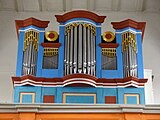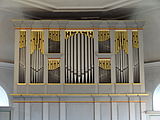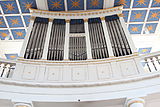Johann Hartmann Bernhard
Johann Hartmann Bernhard (born December 17, 1773 in Romrod , † August 22, 1839 in Romrod) was a German organ builder who worked in Hesse in the 19th century .
Life
(Johann) Hartmann Bernhard came from a family of organs that had been active for several generations up to the beginning of the 20th century. Hartmann Bernhard was the son of the organ builder Johann Georg Bernhard, who came from Oberzell (Sinntal) , and his wife Sophie. His father apprenticed to Adam Adolph Otto in Würzburg for four years (until 1766) and moved to Romrod, where he went into business for himself in the 1770s. Johann Hartmann took over his father's workshop and worked primarily in Hessen-Darmstadt and occasionally in Hessen-Kassel. In 1837 his opus list included 36 works. His students are Johann Georg Markert ( Ostheim vor der Rhön ), Christoph Opitz (Dobra), Adam Eifert (Stadtilm), Friedrich Melchior Zindel (Kassel), Georg Friedrich Wagner (Hersfeld) and Johann Georg Förster (Lich).
progeny
Six children resulted from the marriage with Anna Elisabeth Schlosser from Elpenrod . His son Friedrich Wilhelm Bernhard (1804–1861) took over the Romroder workshop and created organs in Merlau (1857), Windhausen (1845) and Beuern (Buseck) (1847). Another son named Adam Karl Bernhard (1807-1893) also learned organ building and settled in Gambach , where he also worked as a teacher. After Wilhelm's death, Adam Karl set up a workshop in Gambach. Karl's sons Karl Theodor and Karl Rudolf traded as the Bernhard brothers . The two built an organ in Appenrod in 1890 and the organ in the Christ Church (Dietzenbach) in 1891 , which was largely destroyed in the Dietzenbach bombing night in September 1941. The organ building family shaped the organ landscape of Hesse , especially in the 19th century, with numerous works. So far, more than 120 new organs or larger conversions of the family are known.
plant
Hartmann Bernhard is considered the most outstanding figure of the organ builder dynasty. Despite wartime and competitive pressure, he delivered an organ every year, which he designed individually and with characteristic prospectuses . Despite trying to keep up with progressive innovations, traditional craft techniques continued to be used. In 1830 he developed a register drawer , which was advertised as a new invention. Among his successors, the cone chest was introduced from 1884 and the pneumatic action from 1912 . In its early days, the classic prospectus design with a round central tower, lateral pointed towers and flat fields in between can still be found. Afterwards, the flat composite prospectus is characteristic of his works, in which the pipe towers no longer stand out, as was the centuries-old tradition. In addition, the prospectus has a clear geometric design: the alternation of one and two-story pipe fields creates a rectangular area. Bernhard's early works are shaped by the plait style , later largely by the style of classicism . In terms of sound, they still go back strongly to the 18th century and like to use Octave 1 ′ and cymbals. Even with small village organs, a separate pedal with one or two stops is the rule.
List of works
Italics indicate that the organ has not been preserved or only the historical case has been preserved. In the fifth column, the Roman number indicates the number of manuals , a capital "P" indicates an independent pedal, a lower-case "p" indicates a pedal that is only attached. The Arabic number indicates the number of sounding registers. The last column provides information on the state of preservation or special features.
| year | place | church | image | Manuals | register | Remarks |
|---|---|---|---|---|---|---|
| 1808 | Engelrod | Ev. church | I / P | 17th | Replaced in 1859 by a new building by Förster | |
| 1808 | Ober-Ohmen | Ev. church |

|
II / P | 22nd | in braid style; 1855 reconstruction by Wilhelm Bernhard, who replaced some registers; 1970 restoration and relocation by Oberlinger to II / P / 24; received about 13 registers from Bernhard |
| 1808 | Köddingen | Ev. church | I / P | 13 | various conversions | |
| 1809 | Elpenrod | Ev. church | I / p | 8th | Manual register received; After 1945 Schmidt (Gelnhausen) added a sub-bass 16 ′ in the pedal | |
| 1813 | Erbenhausen | Ev. church | I / P | 10 | Braid style housing; Changed in 1952 by Förster & Nicolaus; largely preserved | |
| 1815 | Blofeld (Reichelsheim) | Ev. church | I / P | 9 | Replaced in 1890 by a new building by August Förster | |
| 1817 | Ober-Mockstadt | Ev. church |

|
I / P | 13 | Extent of the renovation in 1884 by Johann Georg Förster unclear |
| 1817-1818 | Heidelbach (Alsfeld) | Ev. church | I / P | 12 | 2007–2009 restoration by Orgelbau Waltershausen | |
| 1819 | Storndorf | Ev. church | Replaced in 1956 by a new building from Walcker | |||
| 1820 | Elections (Kirtorf) | Ev. church | I / P | 12 | largely preserved | |
| 1821/22 | Borsdorf (Nidda) | Ev. church |

|
I / P | 9 | Conversions in 1960 by Förster & Nicolaus and 1978 by Werner Bosch; Most of the registers preserved |
| 1822 | Kelsterbach | Ev. church | II / P | 22nd | Only case with original prospect pipes received | |
| 1823 | Weather field | Ev. church |

|
I / P | 12 | changed several times |
| 1825 | Pfungstadt | Ev. church |

|
II / P | 26th | Largest Bernhard organ, of which 15 stops have been preserved; Disposition according to Christian Heinrich Rinck , 1921/54/81/94 changes by Förster & Nicolaus Orgelbau , 2012/13 restoration by the same company and return to the original condition |
| around 1825 | Dortelweil | Ev. church | I / P | 11 | Attributed to Bernhard; Most of the registers preserved | |
| 1828 | Rodheim-Bieber | Evangelical Church Rodheim |

|
I / P | 11 | Rebuilt in 1958/59; receive |
| 1829 | Oppershofen | St. Laurence |

|
II / P | 23 | Replaced in 1912 by an organ by Michael Körfer (II / P / 16); Housing preserved, 1977 changes in disposition by organ builder Wagenbach |
| 1830 | Holzheim (Pohlheim) | Evangelical Reformed Church |

|
I / P | 11 | New building by Förster & Nicolaus (1968; II / P / 13); Housing and Gedackt 8 ′ preserved |
| 1830/31 | Nieder-Bessingen | Protestant church |

|
I / P | 10 | 1957/58 replaced by a new building by Förster & Nicolaus behind the historical prospectus |
| 1831 | Wissmar | Protestant church |

|
I / P | 17th | Replaced in 1967 by a new building by Günter Hardt , the prospectus by Johann Georg Bürgy (1830) preserved |
| 1833 | Ober-Bessingen | Protestant church |

|
I / P | 10 | One register exchanged in 1891, otherwise completely preserved |
| 1834 | Field crutches | Ev. church | I / P | 8th | Preserved as it was after the 1901 renovation by August Förster | |
| 1834 | Steindorf (Wetzlar) | Protestant church |

|
I / P | 9 | remodeling in the 1960s; receive |
| 1837 | Gleimenhain | Ev. church | I / P | 9 | classical prospectus; Organ largely preserved | |
| 1839 | Village manure | Evangelical Reformed Church | I / P | 8th | reduced in size compared to the contract (I / P / 9) or rebuilt later; Except for the prospectus pipes completely preserved | |
| 1839 | Upper listeners | Ev. church |

|
I / P | 13 | preserved almost unchanged; 1971 free loops Manual Trumpet 8 ', and pedal-Chor Albass 4' of Förster & Nicolaus Organbuilders supplemented |
| 1839 | Heimertshausen | Ev. church | I / P | 8th | receive |
literature
- Hans Martin Balz , Reinhardt Menger: Old organs in Hessen and Nassau (= publication of the Society of Organ Friends . Volume 72 ). 2nd Edition. Merseburger, Kassel 1997, ISBN 3-87537-169-0 .
- Franz Bösken : Sources and research on the organ history of the Middle Rhine (= contributions to the Middle Rhine music history . Volume 6 ). tape 1 : Mainz and suburbs - Rheinhessen - Worms and suburbs . Schott, Mainz 1967, ISBN 978-3-7957-1306-5 .
- Franz Bösken, Hermann Fischer , Matthias Thömmes: Sources and research on the organ history of the Middle Rhine (= contributions to the Middle Rhine music history . Volume 7.1 ). tape 2 : The area of the former administrative district of Wiesbaden. Part 1: A-K . Schott, Mainz 1975, ISBN 3-7957-1307-2 .
- Franz Bösken, Hermann Fischer, Matthias Thömmes: Sources and research on the organ history of the Middle Rhine (= contributions to the Middle Rhine music history . Volume 7.2 ). tape 2 : The area of the former administrative district of Wiesbaden. Part 2: L-Z . Schott, Mainz 1975, ISBN 3-7957-1370-6 .
- Franz Bösken, Hermann Fischer, Matthias Thömmes: Sources and research on the organ history of the Middle Rhine (= contributions to the Middle Rhine music history . Volume 29.1 ). tape 3 : Former province of Upper Hesse. Part 1: A-L . Schott, Mainz 1988, ISBN 3-7957-1330-7 .
- Franz Bösken, Hermann Fischer, Matthias Thömmes: Sources and research on the organ history of the Middle Rhine (= contributions to the Middle Rhine music history . Volume 29.2 ). tape 3 : Former province of Upper Hesse. Part 2: M-Z . Schott, Mainz 1988, ISBN 3-7957-1331-5 .
- Dieter Großmann: Organs and Organ Builders in Hesse (= contributions to Hessian history . Volume 12 ). 2nd Edition. Trautvetter & Fischer, Marburg 1998, ISBN 3-87822-109-6 .
- Eckhard Trinkaus: organs and organ builders in the former district of Ziegenhain (Hessen) (= publications of the historical commission for Hessen . Volume 43 ). Elwert, Marburg 1981, ISBN 3-7708-0713-8 .
See also
Individual evidence
- ↑ a b c Bösken: Sources and research on the organ history of the Middle Rhine. Vol. 1. 1967, p. 35.
- ↑ a b c d Bösken, Fischer: Sources and research on the organ history of the Middle Rhine. : Volume 3, Part 1, A-L . 1988, p. 18.
- ^ Bösken, Fischer: Sources and research on the organ history of the Middle Rhine. Vol. 3, Part 2: M-Z . 1988, p. 662.
- ^ Trinkaus: organs and organ builders in the former district of Ziegenhain (Hesse). 1981, p. 243 f.
- ^ Bösken, Fischer: Sources and research on the organ history of the Middle Rhine. Vol. 3, Part 2: M-Z . 1988, p. 712 f.
- ^ Bösken, Fischer: Sources and research on the organ history of the Middle Rhine. Vol. 3, Part 2: M-Z . 1988, p. 734.
- ^ Bösken, Fischer: Sources and research on the organ history of the Middle Rhine. : Volume 3, Part 1, A-L . 1988, pp. 282-285.
- ^ Bösken, Fischer: Sources and research on the organ history of the Middle Rhine. : Volume 3, Part 1, A-L . 1988, p. 243.
| personal data | |
|---|---|
| SURNAME | Bernhard, Johann Hartmann |
| ALTERNATIVE NAMES | Bernhard, Hartman |
| BRIEF DESCRIPTION | Hessian organ builder |
| DATE OF BIRTH | December 17, 1773 |
| PLACE OF BIRTH | Romrod |
| DATE OF DEATH | August 22, 1839 |
| Place of death | Romrod |

